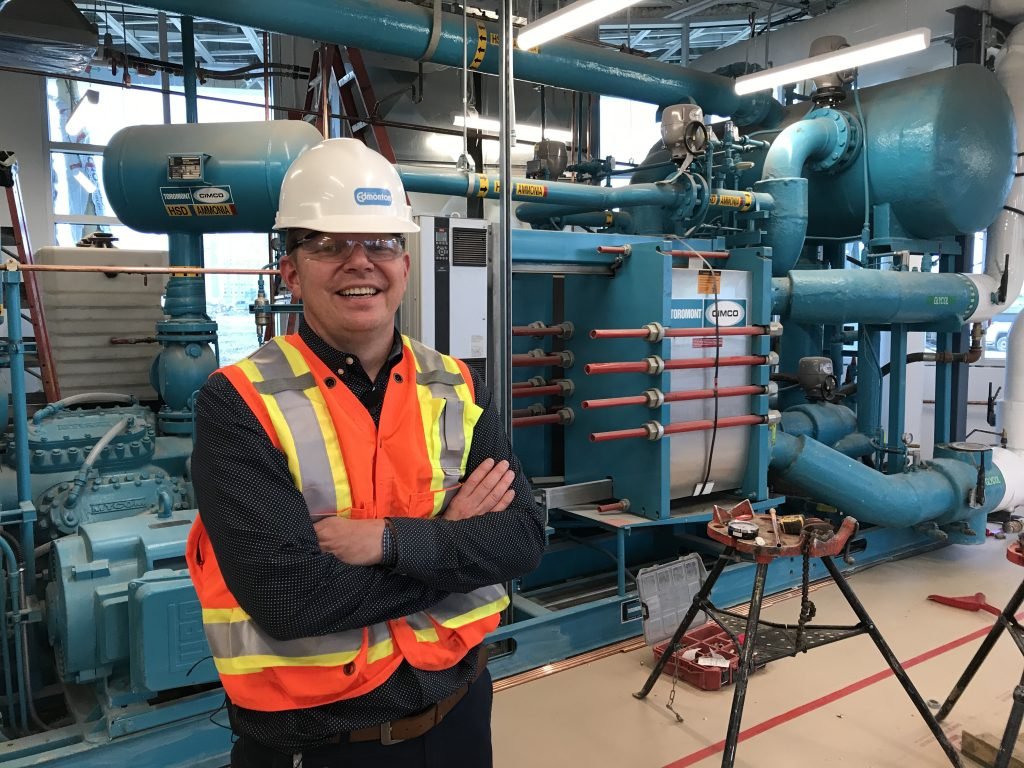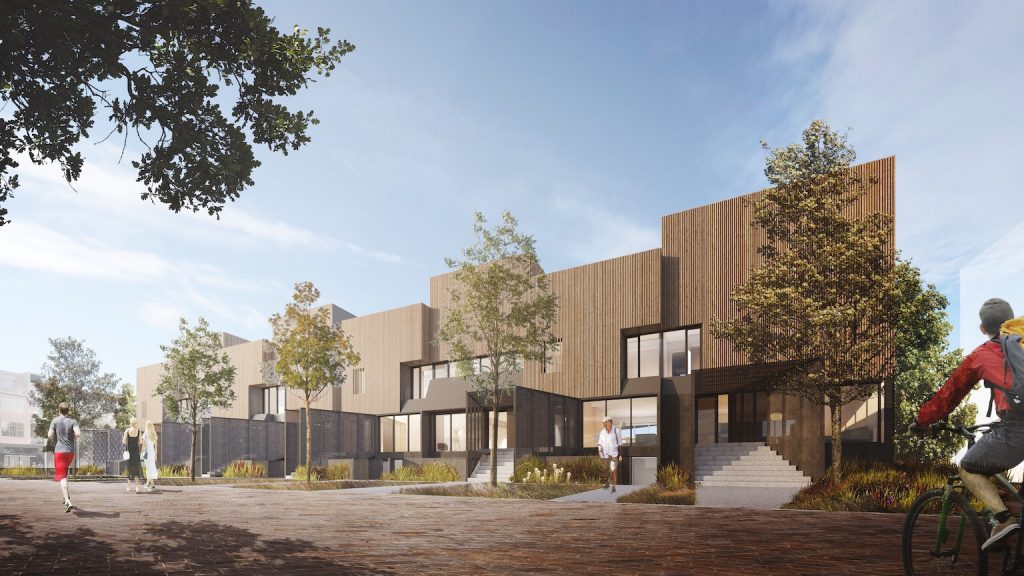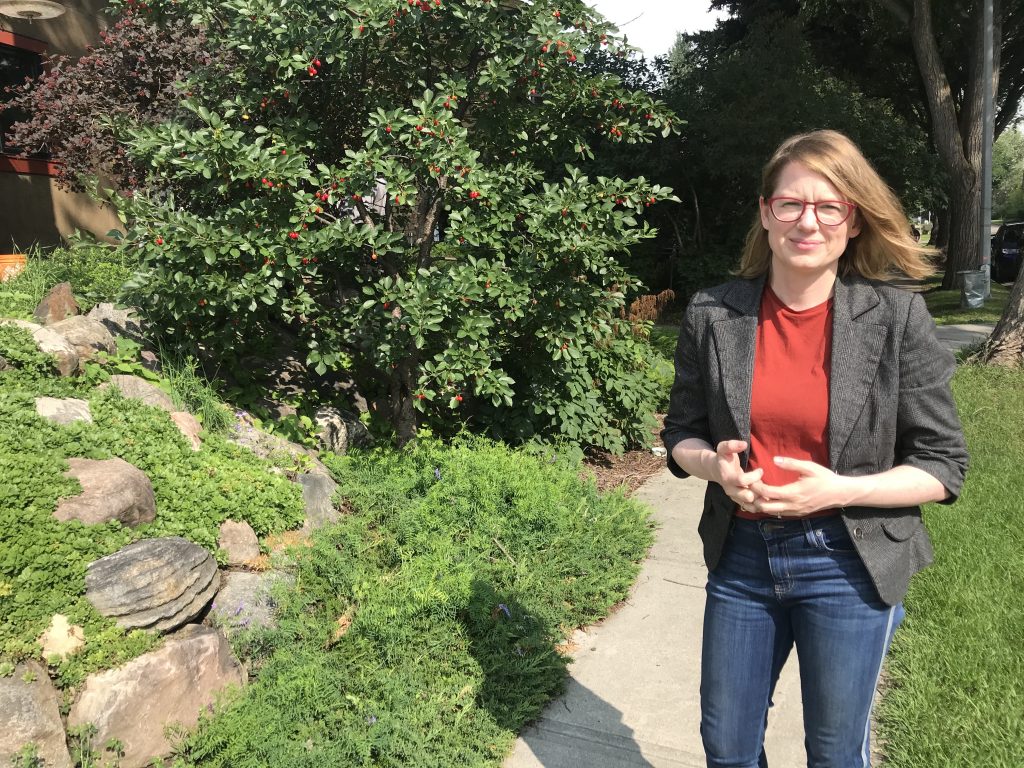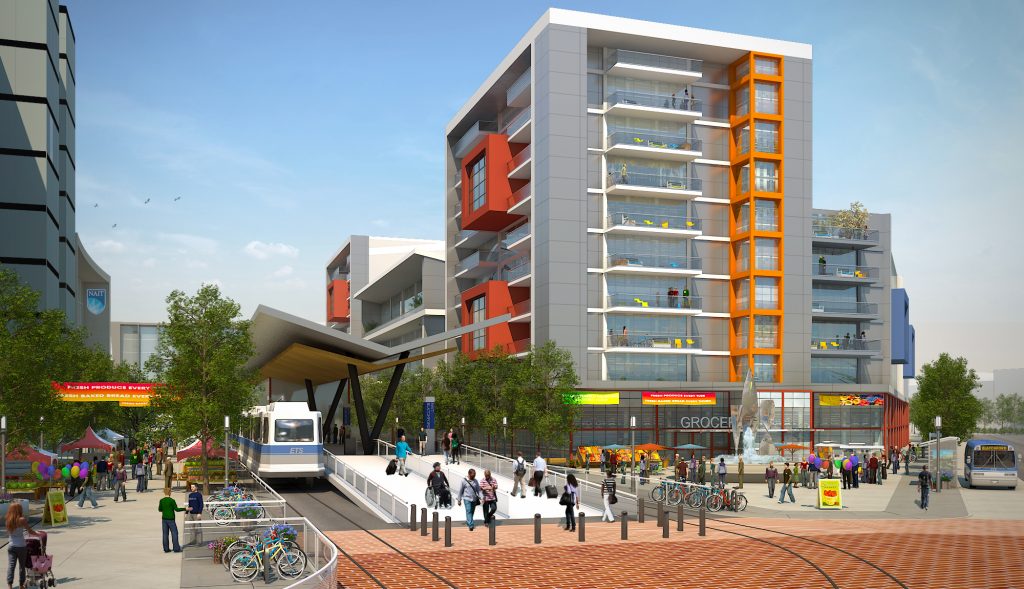By David Dodge and Kay Rollans
Edmontonians have already been recognized as pioneers of net-zero homes, and now they are building the largest carbon-neutral community in the country: Blatchford.
“Not only can we achieve our greenhouse gas reduction goals through expert construction and high efficiency and beautiful buildings, but with the right technology that’s available today, we can achieve a net-zero community,” said Mayor Don Iveson at the sod-turning in September. “We are showing that it can be done at a city-within-a-city scale for 30,000 people here at Blatchford.”
The audacious vision emerged more than a decade ago as a bold answer to the question of what to do with Edmonton’s downtown airport, once known as Blatchford Field. In total, the land in question is a whopping 536 acres — about the size of Edmonton’s current downtown.

Three pillars of Blatchford’s green energy strategy
“Blatchford will eventually be home to 30,000 Edmontonians living in a world-class community which is carbon neutral and entirely powered by renewable energy,” says Christian Felske, director of renewable energy systems at the City of Edmonton, and manager at Blatchford District Energy Utility.
Blatchford’s impressive energy production and use targets will be met through the construction of energy-conserving, high-performance buildings and a highly efficient district energy sharing system fueled by renewable energy such as geo-exchange sewer heat and solar photovoltaic electricity. These, says Felske, represent the community’s three pillars: energy conservation, energy efficiency, and energy renewability.
 Energy Centre One, Blatchford’s first energy centre, is already built. It is a geothermal system that includes the largest heat pump in Edmonton — one of the largest that the Green Energy Futures team has ever seen. The energy centre is connected to a vast array of pipes that will deliver fluids at about 15C to the homes in Blatchford. This system will deliver heat to Blatchford homes in the winter and absorb it in the summer—at an efficiency rate of 400 per cent!
Energy Centre One, Blatchford’s first energy centre, is already built. It is a geothermal system that includes the largest heat pump in Edmonton — one of the largest that the Green Energy Futures team has ever seen. The energy centre is connected to a vast array of pipes that will deliver fluids at about 15C to the homes in Blatchford. This system will deliver heat to Blatchford homes in the winter and absorb it in the summer—at an efficiency rate of 400 per cent!
Forever homes

RedBrick’s Nest 8 Townhomes 
Mutti’s Tarmac 2 Townhomes 
Encore Brooklyn Townhomes 
Carbon Busters Net-Zero Townhomes
You can already buy your place in the sun in Blatchford. The construction of townhome-style homes, chock-full of natural light, began the day of the sod turning in September. Four builders — Ocheller by RedBrick, Carbon Busters, Encore Master Builder, and Mutti Homes — already have homes on the market, though they are yet to be built.
All of the homes fall under Blatchford’s Green Building Code and will be at least twice as efficient as a conventional home.
“Because they’re part of a carbon-neutral community they will have very, very low energy consumption,” says Peter Amerongen, one of the fathers of net-zero homes in Canada and a consultant to two of the builders in Blatchford.
He says the homes are extremely well insulated, very airtight, and have state-of-the-art windows and heat pumps that work with the geothermal district heating system. They’re “built to basically a net-zero–ready level — they’re built about as well as we’ll ever need to build buildings,” says Amerongen.
That’s high praise from Amerongen, who is well known for his high standards and commitment to reducing building emissions. A once-partner with Edmonton-based Habitat Studio, Amerongen now works with Butterwick Construction, a company specializing in energy-efficient retrofits and custom homes. Between the two gigs, Amerongen has been building net-zero homes for almost a decade already—and he understands why it’s so important: “We need to be carbon neutral, fossil-fuel-free essentially in 30 years or the kind of fires and climate catastrophe that you’re seeing in the news every day is going to get way, way worse.”

A sustainable home for sustainable homes
For Tegan Martin-Drysdale, president of one of the Blatchford builders, RedBrick, sustainable homes are only some of the seeds of sustainable urban design needed to ultimately grow sustainable communities. The neighbourhood must, ultimately, be a great place to live.
For Martin-Drysdale, this means, especially, abundant access to the natural world. “I’m really excited about the Blatchford community,” she says. “It’s going to have gorgeous community gardens and one thing I know about human beings is that while we have to live in cities to be sustainable in terms of population growth, we also have to be close to nature … We have to have walkable pathways and we have to be near life and plants and greenery, and I think Blatchford is going to provide that type of lifestyle right in the heart of our city.”

A new standard for Canadian urban design
Amerongen agrees. “It’s a beautifully designed community. From an aesthetic point of view, it offers very excellent urban values.” Beyond aesthetics, Amerongen highlights the degree of mobility that will be available to residents of Blatchford. “It’ll be a very walkable neighborhood, very well connected to the city via LRT and bike paths and … very walkable inside,” he says. “I think it’ll be a fabulous place to live.”
Martin-Drysdale and Amerongen both point to the same thing: sustainable urban design is not just about cutting-edge technologies and incredibly efficient heat pumps. To be truly sustainable, attention must be paid at the human scale. Sustainably designed communities must be located close to things people need, offer efficient and communal forms of transportation, and include great public spaces.
This is called location efficiency: creating environments that allow you to get from place to place with the least expenditure possible of time, energy, and fossil fuels, often because the things you want and need — from parks to jobs to groceries —are already where you are. Location efficiency is great for the environment, for encouraging healthier lifestyles, and for drastically reducing hours spent commuting. Blatchford is stunningly more location efficient than other recent Edmonton-area community developments: it already has LRT on-site, is just 10 minutes from the heart of downtown, and is right next to shopping, a hospital, and — when necessary — a freeway.

A lightning rod for sustainability
The development of the Blatchford vision has been a work-in-progress for almost a decade. With RedBrick, Martin-Drysdale has followed the concept from the beginning, providing input in technical committees and helping shape the design of this sustainable community.
“I’m very passionate about Blatchford I think it’s a game-changer for housing in Canada,” she says.
Martin-Drysdale says Blatchford represents a leap forward in sustainable urban design that will allow people to live more sustainably. As homeowners, Blatchford residents will not only experience “a beautiful design first and foremost,” says Martin-Drysdale, but also “lower utility bills. They’re going to notice higher comfort in the more extreme temperatures, and they’re going to notice a lot of natural light,” she says.

As members of a community, however, Martin-Drysdale sees the beginnings of something quite unique in Alberta: the opportunity to create a of a new kind of community. “The people that move in first are going to get to shape that community like no other community in Edmonton,” says Martin-Drysdale.
“The product that we’re building is going to attract like-minded individuals. It’s a bit of a lightning rod for people that have sustainable values and intentions and want to invest in sustainability in their community,” she says. Blatchford is an opportunity to create a hub for not only of sustainable energy practices, but for a culture-based on sustainable living.
“They’re going set the culture and the tone and they’re going to be welcoming their neighbors as they move in. And I’m really excited to work with our first purchasers to establish that culture in that community in Blatchford,” says Martin-Drysdale, adding that she sees RedBrick being part of Blatchford for a long time to come.



